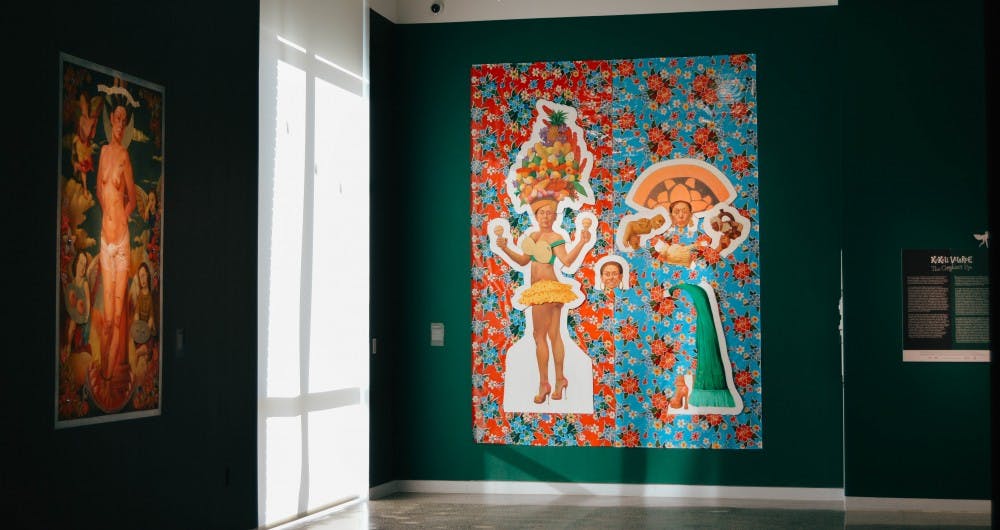Four overhanging lights cast a semi-lit glow within the Taller Puertorriqueño conference room. Housed in the back left corner of the Pennsylvania Academy of Fine Arts, the room's worn and stained carpet gives away its age. In the front of the room sits Kukuli Velarde, about to present on her latest exhibition, The Complicit Eye. The Peruvian artist wears a colorful skirt, to match her quick sense of clever humor. Velarde is unapologetically human, she is a clever composite of all the things I am looking for when entering a museum: honest, firm, and brilliant.
The museum curator begins by asking Velarde about her clothing, to which she replies: “the only American thing I am wearing is my glasses, and it is to fit in with all of you.” I immediately understand her anticipated anxiety of entering a foreign space, particularly spaces such as these — purposefully curated to provoke and inspire. Even when I am I know it is a place I love, like libraries or museums, I am filled with double-checking and second-guessing: should I just wear all black?
She points out that this fear is most pronounced when journeying to museums and college campuses, where the all-too-well-known crave to belong, or at least not stand out, is at its strongest. Yet her art does exactly the opposite. Her newest exhibition, The Complicit Eye, is a retrospective painting series representative of the past fourteen years of her life. All the pieces embody some form of self portrait, which include paintings of herself as a pin-up girl, a grieving Virgin and Pieta figure, and a saint, swollen with pregnancy. Most of the paintings are naked, exposing her to the incisive and introspective public eye. Through the subject's unrelenting vulnerability, the audience is forced to reflect upon their own discomfort, as if it were us and not her who was stark naked.
Half-way through the lecture, Velarde discusses the piece: “Daddy Likee?” The portrait, painted in vibrant jewel toned red, gold, and blue on Amazonian tree bark, displays an undressed woman of archetypal female posing: left hand on hip, right hand supporting her head. Though her posture conforms to Western art history standards, her lips are curved in a smug smile that, to me, suggests hidden rage. The spark in her eye speaks of a defiance that no traditional expectation can constrain. While describing the intent behind the piece, Velarde says, “I am whitening my skin, trying to be you, but I cannot." Her words are a testament to the internal turmoil of one who is pressured to fit in, yet at the same time cannot and will not.
When returning to this piece in the exhibit afterwards, I am confronted with Velarde’s uncomfortable questions: what does it mean to be a woman in a patriarchal society? How am I reduced and flattened into an all-purpose-noun that is both vividly and implicitly archetypal? How do my own notions of what it means ‘to be a woman’ further the mold I want to reject?
The second painting that catches my complicit eye is the mural-in-progress: “Vitruviana and Vitruvianita”. Despite being in its beginning stages, it is the centerpiece of Velarde's exhibition. Once again, Western art standards are set up as the outer scaffolding of a piece whose purpose is to tear it down. One of the panels of the murals shows Velarde in Leonardo da Vinci’s “Vitruvian Man” pose, her arms outstretched and feet planted downwards. Her disfigured body is merged with a chaotic background of formless shapes: scalloped patterns circling her torso and curlicue designs floating above her head. Next to her stands her young daughter.
This mural, though still unfinished, is painful to bear. I always understood da Vinci’s drawing to communicate masculine perfection, with the circles and squares overlaying the male body to serve as scientific quantifiers of such ideals. Now, Velarde places the female body against the same geometrical benchmark. What does it mean for the worth of female bodies to be quantifiably measured? What does it mean to fit inside the shapes? Or to fall outside them?
It’s a question I often ask myself. How many parts of me ‘fit’ into the ideal mold? How many parts do not? And then, the more consuming question: how can I fit into it more? As my eyes travel left, I land on Velarde’s daughter.
I think of my future daughter: the first time she questions if she belongs and the first time she wants to spend her youthful savings on makeup and the ‘right’ things to wear. The times she will only see the parts of her appearance she wants to fix, when the only broken thing are the images of female perfection served on the silver platter of magazine covers and social media campaigns.
I think, also, of my two younger sisters and how much I wish that these questions do not impose themselves into their thoughts. I wonder if they are fated to it. This, I think, is the next question Velarde seeks to dig out of me: how complicit am I in maintaining these gendered standards that I hate so thoroughly?
From her lectures and her technique, I believe that is the inquiry that Velarde wants me to leave with. After discussing at length the desire to fit into prescribed beauty standards, its root causes, and its consequences, I'm left to consider my own 'eye's' role. Perhaps instead of turning my gaze outward, I should look inward. Easier said than done. Yet, these thoughts pull me back to the qualities that drew me to Velarde in the first place. In order to fight back against my doubts, I must begin to be like Velarde: honest, firm, and brilliant.

